![]()
![]()
![]()
Use LEFT and RIGHT arrow keys to navigate between flashcards;
Use UP and DOWN arrow keys to flip the card;
H to show hint;
A reads text to speech;
20 Cards in this Set
- Front
- Back

*ol 1492
|
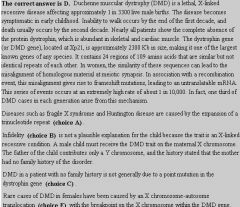
*A recombination event in the dystrophin gene that gave rise to a frameshift mutation leading to an untranslatable mRNA.
--rest of explanation: CHOICE E: Rare cases of DMD in females have been caused by an X chromosome-autosome translocation with the breakpoint on the X chromosome within the DMD gene. Because of the translocation, only the cells in which the normal X chromosome is inativated survice in the female zygote. This gives rise to a female who is heterozygous for the DMD gene but phenotypically expresses the disease. |
|
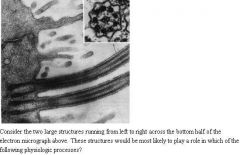
*ol1865
|

*Clearing of mucus from the respiratory tract.
|
|

*ol 1671
|

*Cytochrome b moving into the mitochondria of fibroblasts.
|
|

*ol 928
|
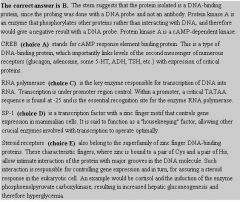
*Protein kinase A
|
|

*ol 373
|
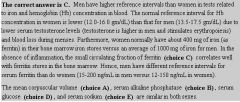
*serum ferritin
|
|

*m200056
|

*Fluorescence in-situ hybridization
--REST OF EXPLANATION: CHOICE E: Spectral karyotyping is a technique that can identify balanced rearrangements. Each metaphase chromosome is labeled with a specific color, so that the entire array of chromosomes may be visualized simultaneously. Twenty-four painting probes and 5 flurochromes are used in combination that uniquely labels each of the autosomes and sex chromosomes. Spectroscopy and an interferometer are used to evaluate the patterns of fluorescence. This allows for the detection of complex rearrangements and small translocations. |
|

*ol 1657
|

*40%
|
|

*ol 1654
|
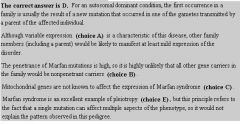
*New mutation transmitted by one of the parents to the affected girl.
|
|
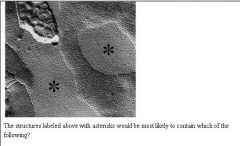
*ol 1864
|

*Connexons
|
|

*ol 1483
|
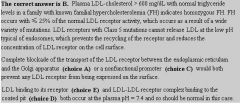
*INCREASED lysosomal degradation of the LDL receptor
|
|

*ol 2026
|
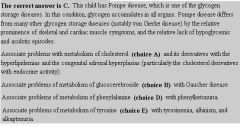
*Glycogen
|
|

*ol2222
|

*Presence of terminal glucose residues on the protein
|
|

*ol 962
|

*Chylomicrons
|
|

*ol 2063
|
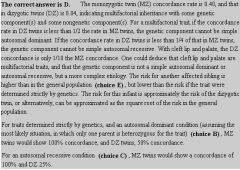
*4%
|
|

*ol 1279
|

*Calcium bilirubinate
|
|
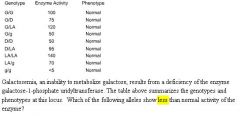
*ol 239
|

*D and g
|
|

*ol 795
|

*EXPANDED TRINUCLEOTIDE
--REST OF EXPLANATION: CHOICE D: Trisomy 13 (Patau Syndrome) is characterized by microcephaly, mental retardation, cleft lip and palate, polydactyly, and rocker-bottom feet. Survival is rare beyond one year. *CHOICE E: Trisomy 18, Edwards syndrome, is characterized by mental retardation, micrognathia, low-set ears, cardiac defects, renal defects, and rocker-bottom feet. Survival is rare beyond one year. |
|

*ol 1136
|
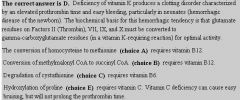
*Formation of gamma-carboxyglutamate residues.
|
|

*ol 1386
|
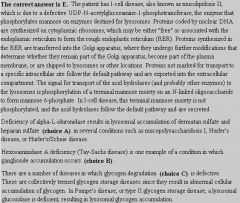
*Phosphorylation of mannose moieties.
--REST OF EXPLANATION: *CHOICE D: Deficiency of sphingomyelinase, an enzyme involved in degradation of sphingomyelin, results in Niemann-Pick disease. *CHOICE F: Phosphorylation of tyrosine moieties is unrelated to lysosomes or lysosomal enzymes; however, DECREASED ability to phosphorylation tyrosine moieties might be associated with diabetes or dwarfism. |
|

*ol 542
|

*16
|

